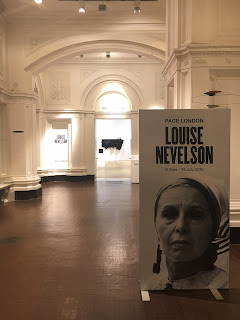L: Crashing Wave (2011) R: Renny's Right Geometry of a Wave (2011)
In general, I find geometric abstraction difficult to engage
with. From artists such as Mondrian and Malevich
through to Riley et al, I usually am pretty much immune to the aesthetics of such
paintings. I prefer brushstrokes to be
more animated and expressionistic. It
would seem though, that I am not entirely immune as I was unexpectedly
surprised to be drawn to a number of Heilmman’s colourful canvases on display in
this exhibition, the first major survey of the artist’s work held in the UK.
Johngiorno (1995)
Ming (1986)
Born in 1940 in San Francisco and still very much active
today, the Whitechapel describes Heilmann’s work as a playful approach to abstraction
and an amalgamation of her LA beach life, 1960s counter culture and her
friendships with artists, musicians and poets of the New York minimalist art
scene. Heilmann graduated from the
University of California at Santa Barbara in 1962. After studying poetry and ceramics at San
Francisco State University, as well as ceramics and sculpture at University of
California at Berkeley, she moved to New York where she began a career as a
sculptor. She began making paintings in
the 1970s. Her work is described as combining elements
of abstraction and Conceptual Art with the bright colours, wit, and playfulness
of the Pop Art. Having just visited the
Royal Academy’s annual summer and student shows, I can confirm that this is a combination
which still continues to influence many art school graduates today.
L: Our Lady of the Flowers (1989) R: Robert’s Garden (1983)
While many of Heilmann’s highly colourful canvases were too
dazzling for me, I did find some pieces, such as Ming (1986), Our Lady of the
Flowers (1989) and Robert’s Garden
(1983), very compelling. The
standout piece for me was Johngiorno
(1995). In this painting, Heilmann’s
practice of combining two or more favoured motifs here spots, stripes and webs,
form a serene composition with subtle colourful highlights, rather than the
usual cacophony of colour. What also struck
me about this exhibition, was how well Heilmann’s ceramic pieces displayed with
the canvases, worked so well. The
addition of glazed ceramic dots to the very garish Good Vibrations Diptych, Remembering David (2012), significantly
increased its appeal to me. Perhaps the
positioning of such work together was a curatorial device. If it was, it was a very clever one and much appreciated
by this viewer.
L: Piano (1983) [glazed ceramic] R: Pink Sliding Square (1978)
L: Shadow Cup 2 (1985 [glazed ceramic] R: Black Cracky (1990)
Another observation that particular struck me about this exhibition,
was how confident Heilmann’s most recent work was, and almost indistinguishable
from her work from the 1980s when she was considered to be at the height of her
artistic powers. This is a rare occurrence
within an artist’s oeuvre, and a refreshing discovery. The exhibition at Whitechapel Gallery
features 45 paintings as well as a selection of ceramics and works on
paper. If you want to escape the gloom
of the English weather and/or political climate, a visit to see Heilmann’s
colourful paintings are almost guaranteed to raise the gloomiest of spirits.
Good Vibrations Diptych, Remembering David (2012)












